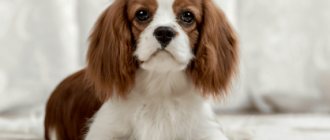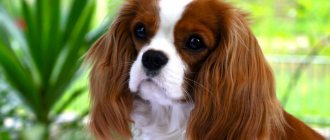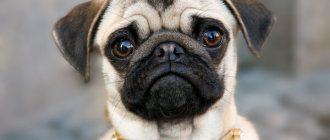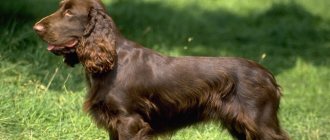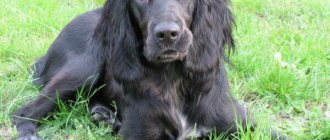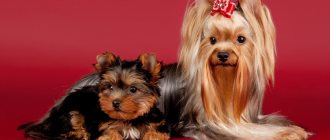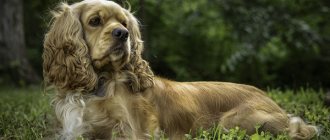Breed card
- Famous breed names: Cavalier King Charles Spaniel, Cavalier, King Charles
- FCI breed number: 136
- Description of the standard on the FCI website: link
- Height at withers: up to 33 cm
- Adult dog weight: up to 8 kg
- Color options: Blenheim, ruby, tricolor, black and tan
- Lifespan: 10-12 years
- Puppy cost: from 15,000 to 40,000 rubles
- Size: 1 of 5
- Learning ability: 4 out of 5
- Attitude towards children: 5 out of 5
- Shedding intensity: 2 out of 5
- Protective and guard qualities: 1 out of 5
Feeding
More often, allergies are detected to chicken, so you can change the food containing lamb or veal.
The meat component is only with low-fat varieties due to the fact that dogs are prone to obesity. Wheat can cause allergies in your pet. It is better to select calorie intake based on the lifestyle of the King Charles Spaniel.
During the period of active growth, your pet's eyes may become very watery and red. It may be possible to initially choose hypoallergenic food to avoid diseases.
Take the Attention Test! Find 10 differences! (click right here!)
Find the answer Are you bothered by some problem or question? Enter “Breed” or “Name of the problem” into the form, press Enter and you will find out everything about the issue that interests you.
The presence of artificial dyes and flavors in the diet is unacceptable; their presence can even turn the undercoat pink over time.
Characteristic
The International Federation of Cynologists classifies the breed as a decorative breed and places the dogs in the spaniel section. The gentleman is active, affectionate and trusting of others, calm. He is not inclined to show aggression or increased excitability.
Breed standard FCI No. 136
According to the standard, the Cavalier Spaniel is a compact, well-built dog with a small head, a wedge-shaped filled muzzle and a flat skull. The muzzle ends with a black nose with prominent nostrils, well-developed lips tightly covering strong jaws with a perfect full scissor bite.
Large, bulging eyes are set widely apart, the color of the iris ranges from dark brown to black. The ears are set high on the head, covered with abundant fur with fringes.
The straight line of the back ends with a straight croup and a tail decorated with lush hair. When excited, the tail rises above the line of the back, and carries down when moving. The King Charles moves calmly and elegantly, and when running it pushes off sharply with its hind legs.
A breed fault is considered to be any deviation from the standard in the appearance or character of a dog.
Dimensions, weight and height of the breed
The standard defines the Cavalier King Charles Spaniel as a well-proportioned dog, but does not specify exact height parameters. On average, the height at the withers, characteristic of representatives of the breed, is up to 33 cm. The permissible weight according to the standard is 5.4-8 kg.
Cavalier King Charles Spaniel: photo, description, character, price
Possible colors
The Cavalier Spaniel's coat is silky and soft, lying in a light wave, but not curly. Decorating hair grows abundantly on the ears, limbs and tail. Trimming is not required for exhibitions.
Four types of coat colors are acceptable:
- Blenheim - pearly white with chestnut spots;
- tricolor - white with red and black spots on the ears, limbs and cheekbones;
- black and tan - orange markings on eyebrows, chest, paws and cheekbones;
- ruby – a solid, bright red hue.
The Blenheim color is characterized by a diamond-shaped marking of a chestnut shade in the central part of the forehead.
Puppy weight by month
King Charles Spaniel puppies develop differently. The parameters for matching the age and weight of the puppies below are approximate. You can use them as a guide, but don’t worry if your dog gains weight more slowly.
Weight-for-age for the Cavalier King Charles Spaniel:
- 1 month – 900 g;
- 2 months – 1.4-2 kg;
- 3 months – 2.2 kg;
- 4 months – 2.5 kg;
- 6 months – 3.6 kg;
- 9 months – 4.3 kg
- 12 months – 4.5-6 kg.
Lifespan
Cavaliers live up to 12 years, like most decorative dogs. In order for your pet to feel good even in old age, he needs to be provided with a balanced diet and a sufficient level of activity.
Allergenicity
The King Charles Spaniel has little undercoat and practically does not shed. Allergy sufferers should talk to a dog of this breed before purchasing, and to make sure that a reaction does not occur, contact an allergist.
Cavalier King Charles Spaniel: photo, description, character, price
Rating of the 10 best dry food for King Charles Spaniel
| Place | Name | Rating | Price, rub. |
| 1 | 1st Choice Breeders for miniature breeds with chicken (20kg) | 5.0 / 5 | 7335 |
| 2 | ProNature Holistic (for miniature breeds) (0.34 kg) | 5.0 / 5 | 435 |
| 3 | Orijen Original (6 kg) | 4.9 / 5 | 3840 |
| 4 | Go! Natural Holistic (holistic menu) Go & NOW Natural (690 g) | 4.9 / 5 | 424 |
| 5 | Ontario "Mini Weight Control" for small breed dogs, with turkey and potatoes (2.25 kg) | 4.8 / 5 | 799 |
| 6 | NOW FRESH salmon, duck, turkey (2.72 kg) (for miniature breeds) | 4.8 / 5 | 1569 |
| 7 | Acana Heritage (6 kg) (for small breeds) | 4.8 / 5 | 3404 |
| 8 | Wolfsblut Gray Peak Small Breed (15 kg) | 4.8 / 5 | 6342 |
| 9 | Grandorf (3 kg) Lamb with rice Mini | 4.7 / 5 | 1600 |
| 10 | Royal Canin for healthy skin and coat 2 kg (for small breeds) | 4.7 / 5 | 625 |
History of the breed
There are two theories about the origin of the Cavalier King Charles breed. According to the first, in the 11th century, during the reign of King Canute, dogs similar to spaniels were brought to Britain, where they were used for hunting. Later, the handsome spaniels were appreciated by families of aristocrats and began to have them as palace dogs.
The second theory connects the Cavalier's ancestors with Italian small dogs, which were brought to England by the knight Fitz-Ralph from the crusade.
It is reliably known that Cavalier King Charles Spaniels have been popular in England since 1554. They were indispensable companions of rich families of that time. During the reign of Elizabeth I, small dogs lived in the palace, brought joy to their owners, and confirmed their high status to those around them. In the 14th-17th centuries. King Charles spaniels were depicted on their canvases by famous painters - Titian, Jean Watteau and others.
The breed's greatest popularity came during the reigns of Kings Charles I and Charles II. The latter adored his dogs - they were allowed to enter any part of the palace and even attend meetings of the British House of Commons. The dog got its elegant name from King Charles.
The first toy spaniel club was created in 1886 in England. The first dog shows began to be organized at the end of the 19th century, and at the same time they were actively engaged in breeding. As a result of breeding work, the breed gradually began to lose its original appearance, and in 1926 a group of English enthusiasts under the leadership of Roswell Elridge decided to revive it. At the Craft show they created a separate class of dogs similar in type to the original King Charles type, and established a prize for the best match. In 1928, the prize was awarded to a male named Anns Son. It was he who became the founder of the breed - in 1945, a standard was drawn up from the dog, approved by the English Kennel Club. At the same time, Cavalier Spaniels were exported to New Zealand, America and other countries, where they quickly gained popularity.
Education and training
Possessing pronounced intelligence, quick wit and good memory, King Spaniels quickly understand the requirements placed on them. They easily master commands and willingly repeat movements and poses.
Expert opinion
Anna Abramenko
An avid dog lover. Experience in veterinary medicine since 2009.
Ask a Question
Dogs do not tolerate roughness. During the training process, you need to act gently, be patient and encourage your pet.
Training begins from the first days the puppy lives in the house. At the initial stage, he must understand his nickname and respond to it.
Gradually the tasks become more complicated. The assignment of rules of behavior in the premises requires special attention. All negative habits should be strictly, but without punishment, suppressed. This will prevent the appearance of an adult dog on the bed or table.
On walks, they develop skills of calm behavior in the presence of large crowds of people and the appearance of other animals. From an early age, a mini spaniel should not be afraid of cars.
All members of the household, including children, can deal with issues of education, since the Cavalier King Charles does not single out a leader.
Character
The Cavalier King Charles Spaniel is a gentleman. He does not force communication, but loves to be the center of attention. The dog is great for large families in which someone constantly communicates with him. Left alone for a long time, the spaniel becomes apathetic and loses interest in games and walks. In the absence of its owners, it barks and whines, expressing sadness.
He loves to travel with his owners, both short distances - to the store or on a visit, and long distances. Easily adapts to the pace of life of any person. He is friendly towards strangers, but sometimes shows timidity in communication. Therefore, a cavalier puppy requires socialization from childhood. He gets along easily with other pets, but does not allow himself to be offended - he bites his oppressors.
From time to time, a hunting instinct manifests itself in its character - the dog happily chases moving objects, snatches away sticks and toys, and chases cats into trees with joyful barking.
Cavalier King Charles Spaniel - description of the breed
Life expectancy and major diseases
Cocker Charles spaniel dogs, as they are also popularly called, have good immunity and, with proper care and nutrition, are very rarely exposed to diseases. But despite this, there is still a possibility that these dogs will develop the following diseases:
- arthrosis;
- retinal dysplasia;
- flycatching;
- lesions of intervertebral discs;
- mitral valve stenosis.
The lifespan of a Cavalier King Spaniel is approximately 12 years on average. If the dog eats a proper and balanced diet and is properly cared for, its life expectancy can increase significantly and will exceed 15 years.
Learning ability
The cavalier should be taught a standard set of commands. Thanks to his inquisitive mind, he can be trained quickly, especially if the owner uses positive reinforcement.
Spaniels are most receptive to training between the ages of one month and six months. During this period, special attention should be paid to raising the puppy. Establish a set of rules in the house and demand their implementation. Before training, the baby must learn a nickname, then get used to the leash and collar.
The commands are introduced sequentially - training begins in a calm environment with the commands “Sit!” and “Lie down!”, then “To me”, “Near” and others are added. When the skill is consolidated, complications are introduced - endurance and distractions.
The spaniel is sensitive to the intonations in the owner's voice - all commands must be given in an even and clear voice, without shouting. Be sure to joyfully praise after a successful exercise and encourage it with a treat. The worst punishment for this dog is the owner's harsh tone; spanking, even weak, is unacceptable.
Rules for choosing puppies
Expert opinion
Anna Abramenko
An avid dog lover. Experience in veterinary medicine since 2009.
Ask a Question
In order not to make a mistake and purchase a purebred dog, turn to reputable kennels. They will offer a baby at least three months old who has already completed all the necessary vaccinations.
Such puppies adapt more easily to new conditions. Documents confirming compliance with the standard and describing the pedigree must be attached.
During a visual examination, attention is paid to the absence of aggression or excessive cowardice. Check the condition of the ears and eyes, which should be clean. By tactile palpation of the tummy, the absence of bloating is determined, which may indicate problems with digestion.
Content
You can keep a Cavalier King Charles Spaniel in an apartment or in a private house. The main thing is to provide the dog with a warm bed away from drafts.
Need for physical activity
The spaniel does not require much physical activity, although it can run around the street all day. The optimal duration of a walk in warm seasons is half an hour, in winter – 15-20 minutes. In the cold season, be sure to dress the dog in warm overalls and periodically pick it up while walking, giving it the opportunity to warm up.
During pregnancy, the bitch's walking routine should not be changed - at the end of the pregnancy she herself will not want to walk too far. The only thing you should do is reduce physical activity. Starting from the fourth week of pregnancy, it is forbidden to bathe the bitch - after a walk you can only wipe her paws.
Cavalier King Charles Spaniel - photo, breed description, price
Appearance care
The coat of the Cavalier King Charles Spaniel should be brushed with soft brushes twice a week and washed once a month. When washing, use insecticidal shampoos to prevent the formation of fleas.
To avoid the appearance of ear mites, it is necessary to inspect your pet's ears every day and wipe them weekly with a cotton pad soaked in a chlorhexidine solution.
If dark discharge appears from the ears, the dog should be taken to the veterinarian.
Discharge from the eyes should be removed daily with a soft cloth, and a cleaning lotion from a veterinary pharmacy should be instilled into the eyes twice a week. Brush your teeth with a soft brush; in addition, you can give your dog treats to clean his teeth.
Claws should be trimmed with a nail clipper as they grow. In the summer, while walking on the asphalt, they wear down on their own, and in the winter they require maintenance.
Nutrition
Owners of King Charles Spaniels carefully control the diet of their pets - the dogs are allergic and prone to obesity.
Dry food is selected taking into account the breed characteristics, trying to ensure that the composition does not contain chicken and wheat. A natural diet is formed on the basis of boiled meat and cereals, adding vegetables and low-fat fermented milk products. Never give your dog sweets, fatty and smoked foods, bones, exotic fruits and spices.
Care and maintenance
Representatives of the breed can be kept in a spacious house or in a standard apartment. They will not create any difficulties for their owners.
It is imperative to provide a place for your four-legged pet to live. If possible, you can buy a house for dogs; gentlemen simply love to hide in a “mink”. If there is no space for a bulky structure, it is enough to purchase a lounger at a pet store.
The dog cannot live on the street forever!
But if you own a house, you can cut a special door into the door so that your baby can go out into the yard and come back on his own if necessary.
Walks
Despite the fact that the gentleman does not need long intensive walks, it is still not worth giving up daily walks. You need to walk your dog at least once a day to keep it in good physical shape.
If you like to walk and want your King Charles Spaniel to constantly keep you company, increase the load gradually.
Hygiene
A royal dog does not require royal grooming. Careful attention will have to be paid to the cavalier's drooping ears, as they are poorly ventilated and may suffer from otitis media. Every week you will have to wipe the animal’s ears with a swab dipped in a special hygiene lotion.
A shortened muzzle causes increased sensitivity of the visual organs. Not only do eyes become watery in strong winds, but they are also exposed to a variety of infections. You will have to examine the eyes of your four-legged family member and wipe them daily.
Photo: https://pixabay.com/photos/portrait-cute-dog-animal-small-3141031/
You will need to trim your dog's nails monthly using scissors or a nail clipper. The reason is that the animal’s claws do not wear down naturally, since the dog does not walk very much and its weight is insignificant. Also a mandatory procedure is cutting the fur between the toes of a domestic animal.
Cavaliers live 12-14 years, and with proper care they can live up to 16.
Bathing a Cavalier Spaniel is often not recommended. When bathing regularly, you need to use special detergents for animals and make sure that water does not get into your pet’s ears and eyes.
After bathing, the animal's fur should dry well. Otherwise, the dog may get sick if exposed to a draft.
You also need to pay attention to the teeth of your four-legged pet. To remove natural plaque, you can treat your animal with hard treats such as toothpicks or brush his teeth using a brush and dog toothpaste for this purpose.
Feeding
Representatives of the breed can be fed both natural products and dry food. Given the predisposition of dogs to allergies, it is necessary to exclude chicken and other foods that can cause allergies from their diet.
With natural feeding, allowed foods are veal, offal, eggs, rice and buckwheat porridge, lean fish, seasonal vegetables, kefir and cottage cheese, also low-fat.
All foods from the human table will have to be excluded from the diet. Prohibited are sweets, hot and spicy foods, sausages, and tubular bones.
If you don’t have the time or desire to prepare your pet’s food yourself, you can purchase ready-made premium or super-premium dry food. They contain everything necessary for the harmonious development and health of your pet.
Grooming
Your pet's fur requires close attention. The dog will have to be brushed daily. After walking, be sure to remove any debris stuck in your long hair. During molting periods, your cavalier will have to be scratched more often.
Spaniels do not need a haircut.
If, due to an oversight, your four-legged pets still have tangles, you should not rush and grab the tangle cutter. You can try to sort out the tangled hairs using a comb or hair conditioner. With the help of conditioner, even applied to a tangled strand for a short time, you can unravel even the worst tangle.
Under no circumstances should the dog lick the product designed to facilitate untangling.
Typical diseases of this breed
The most common disease in cavaliers is heart disease, mitral regurgitation. It can occur at any age and is characterized by a heart murmur.
Other breed diseases:
- allergy;
- diabetes;
- arthritis;
- hernia;
- dislocation of the kneecap;
- retinal dysplasia.
Nutrition for puppy and adult dog
Dogs need to be fed correctly. Organizing a diet based on professional feed is considered the most convenient. They are able to provide the animal with all the necessary elements and vitamins.
Food should be selected depending on the age of the dog. At the same time, preference should be given to options no lower than premium class. The difference in feeding puppies and adult animals is the number of servings.
Important! Puppies are fed five times a day, while adult animals need two feedings a day.
Buying a puppy
To buy a Cavalier puppy, find breed clubs and breeders in your city. Find litters ready for sale and study the pedigrees of the parents. Ask the breeder questions about typical diseases of the breed and possible difficulties. Answer his questions about the future conditions of keeping the puppy.
Examine the litter and choose the puppy with the best conformation and personality traits. A promising puppy must have:
- well developed nostrils;
- sloping forehead;
- large eyes, widely spaced;
- scissor bite;
- arched neck;
- normal muscle tone;
- the behavior of a “gentleman” is a calm attitude towards others, adequate communication with fellow humans.
Advantages and disadvantages
Analysis of the strengths and weaknesses will allow you to evaluate the advantages of the breed.
Advantages:
- high intelligence;
- devotion;
- friendliness;
- good learning ability;
- gracefulness and decorativeness.
Comparing the pros and cons, you can see that this breed has practically no disadvantages. Only high prices for puppies can scare away potential owners.
Interesting facts from the life of dogs
According to historical sources, it is known that Mary Stuart, the Scottish Queen, was accompanied to her execution by King Charles Spaniel.
Queen Victoria of Great Britain adored this breed, which was the root cause for the production of clay figurines of these domestic animals in the 17th century, which are now valuable antiques.
Thanks to their dignified, calm behavior, representatives of this royal breed were allowed to be present at parliamentary meetings. Princess Anastasia Romanova was the owner of such a dog.

